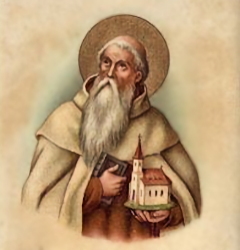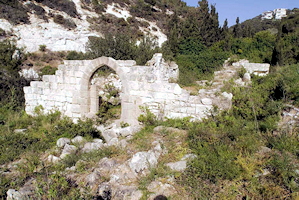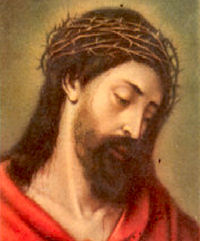Lent: March 29th
Thursday of the Fifth Week of Lent
Other Commemorations: Bl. Berthold of Mount Carmel (RM) ; Other Titles: Berthold of Calabria
» Enjoy our Liturgical Seasons series of e-books!
"'Sir, come down before my child dies.' Jesus said to him, 'You may go; your son will live.'" The Gospel reminds us that Christ is God, that His divine Person is omnipresent, that even when not visibly present to us He can heal our soul as He cured the absent son of the ruler.

The Station in Rome is in the church of St. Apollinaris, who was a disciple of St. Peter, and afterwards bishop of Ravenna. He was martyred. The church was founded in the early Middle Ages, probably in the 7th century.
Meditation - The Eloquence of Jesus' Silence
How singularly majestic must have been the eloquence of Jesus, when as a boy He sat among the doctors of the law in the temple, or when He thrilled the multitudes, commanded the winds and waves, and put to flight diseases and demons and death itself! Yet, perhaps nowhere else did the majesty of His eloquence reveal itself, as it did in that heroic calm and consistent silence, which reached its climax in the three hours of His agony.
But what should strike us most forcibly, and yet most sweetly, is the interior silence of Jesus, the silence of His innermost soul and heart, of His human passions, of His feelings and thoughts and fancies. Recall the word of Jesus, that from the heart come forth evil works, bitter zeal, and false testimonies and blasphemies (Matt. 15:19); and then dwell on His own strikingly consistent example of quashing all bitterness and quenching all the fires of passion, and of refraining from impatience, anger, and retaliation, even when tongues all around were busy kindling fires of hateful calumnies against His truest self-knowledge and wounding His livest self-respect.
Hence, pray that you may see deep into the interior soul of Jesus, there to realize the true majesty and marvelous eloquence of the silence of His lips and tongue, the silence which was the fruit of His charity and of the interior peace and perfection of right order that ever reigned within the sanctuary of His heart, the silence which was the precious fruit of the obedience and humility in His absolute abandonment to the mysterious providence of His Father in heaven. — Our Way to the Father by Rev. Leo M. Krenz, S.J.
Bl. Berthold of Mt. Carmel
 Blessed Berthold seems to have had a connection with the beginnings of the Carmelite Order. He was a relative of Aymeric, the Latin patriarch of Antioch who was installed in Antioch during the crusades. At the time, there were a number of hermits from the West scattered throughout Palestine, and Berthold gathered them together, founded a community of priests who settled on Mount Carmel, and became their first superior.
Blessed Berthold seems to have had a connection with the beginnings of the Carmelite Order. He was a relative of Aymeric, the Latin patriarch of Antioch who was installed in Antioch during the crusades. At the time, there were a number of hermits from the West scattered throughout Palestine, and Berthold gathered them together, founded a community of priests who settled on Mount Carmel, and became their first superior.
There is a legend that he was born at Limoges in France, studied in Paris, and was ordained a priest there. According to the legend, he accompanied Aymeric on the crusades and found himself in Antioch when it was being besieged by the Saracens. Through his urgings, the Christians in Antioch turned to prayer and penance, and the city was delivered.
What is known for certain is that Bl. Berthold directed the building of a monastery and church on Mount Carmel and dedicated the church in honor of the prophet Elias, who had defeated the priests of Baal there and seen the vision of the cloud out over the sea. This is confirmed in a letter of Peter Emilianus to King Edward I of England in 1282.
 Berthold lived out his days on Mount Carmel, ruling the community he had founded for forty-five years until his death about 1195. His example and way of life stamped the beginnings of the Carmelite Order, leading to the drawing up of the order’s rule by St. Albert, Latin patriarch of Jerusalem, about 1210. That rule was approved by Pope Honorius III in 1226 and it is this primitive rule that is considered the foundation of the Order of Mount Carmel.
Berthold lived out his days on Mount Carmel, ruling the community he had founded for forty-five years until his death about 1195. His example and way of life stamped the beginnings of the Carmelite Order, leading to the drawing up of the order’s rule by St. Albert, Latin patriarch of Jerusalem, about 1210. That rule was approved by Pope Honorius III in 1226 and it is this primitive rule that is considered the foundation of the Order of Mount Carmel.
But it seems to have been Berthold who first organized the monastic life of the hermits on Mount Carmel and governed them until his death. St. Brocard, who apparently was his successor, petitioned Albert to compose a rule for them, undoubtedly codifying and completing the work begun by Berthold.
—Taken from ucatholic.com
Highlights and Things to Do:
- Read more about Bl. Berthold:
- Read more about about the Order of Carmel: On the History and Spirit of Carmel.






